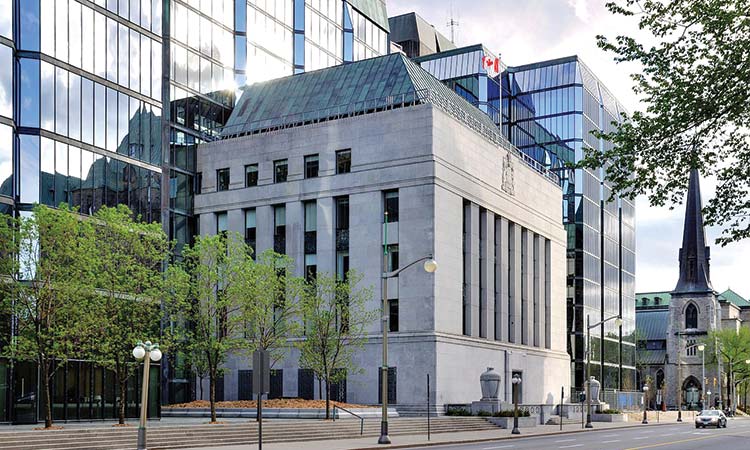Canada inflation seen above 2%, hikes interest rates to 5 per cent

People shop at a Walmart Supercentre in Toronto, Ontario, Canada. Reuters
The Bank of Canada (BoC) hiked its key overnight rate by a quarter of a percentage point to 5 per cent, the highest level since 2001, saying it feared that efforts to return inflation to its 2 per cent target could stall amid excess consumer spending.
The Bank of Canada’s move to increase borrowing costs by 25 basis points for the second time in as many months was expected by analysts and markets. After a five-month pause, the BoC raised its overnight rate in June saying monetary policy was not sufficiently restrictive.
The BoC in its statement dropped the line saying rates were not restrictive enough but it revised higher its growth forecast for this year and pushed back its expectations for getting inflation to target by six months to mid-2025.
“With three-month measures of core inflation running in the 3.5 per cent-4 per cent range for several months and excess demand persisting, concerns have increased that CPI inflation could get stuck materially above the 2 per cent target,” the BoC said in a statement.
Canadian money markets increased bets for another rate hike after the move, seeing rates at 5.14 per cent in December compared with 5.08 per cent before the rate announcement.
The Canadian dollar strengthened to 1.3157 versus the US dollar after the rate hike, up 0.6 per cent on the day.
Despite nine previous rate increases totaling 450 basis points since March of last year, the economy regained momentum in May, likely growing 0.4 per cent on the month, after stalling in April.
The BoC raised its forecast for second-quarter annualised quarterly growth to 1.5 per cent from 1.0 per cent in April, and growth is seen expanding 1.5 per cent also in the third quarter. Overall 2023 real gross domestic product growth is seen at 1.8 per cent compared with its April forecast of 1.4 per cent.
“The rebalancing of supply and demand is now expected to happen in early 2024,” the BoC said it its report containing new forecasts also released on Wednesday.
Though headline inflation slowed to 3.4 per cent in May, less than half of last year’s 8.1 per cent peak, the three-month annualized rates of the BoC’s core measures have not been coming down.
Surprisingly persistent demand, higher-than-expected housing costs and a more gradual decline than expected in goods prices, excluding food and energy, are fueling inflation, the BoC said.
“Inflation is expected to return to 2 per cent in the middle of 2025, although the timing is uncertain given the gradual movement of inflation toward the target,” the BoC said. The BoC’s overnight target rate was last at 5.00 per cent in March and April of 2001.
Twenty of 24 economists surveyed by Reuters had expected the central bank to lift rates by a quarter of a percentage point. Money markets had seen a more than a 70 per cent chance of a rate hike before the announcement.
The Bank of Canada’s interest rate hike on Wednesday and prospects of more increases heighten risks to mortgage lenders as homeowners are likely stay in debt longer as they struggle to make higher payments or pay even the interest portion of their home loans, investors and analysts say.
After urging lenders to tackle the risks from a sharp rise in borrowing costs, Canada’s main banking regulator, Office of the Superintendent of Financial Institutions (OSFI), on Tuesday proposed tougher capital rules for lenders to prevent consumers from defaulting or entering negative amortization.
Negative amortization occurs when variable home loan customers’ monthly repayments are not enough to cover the interest component of home loans. Which means the excess amount gets added to the outstanding loan, thereby lengthening the repayment period.
“All of that is a realisation that there is stress in the system,” said Greg Taylor, Chief Investment Officer of Purpose Investments.
“There’s definitely more risk because anytime you hike you never know when it’s going to be the straw that breaks the camel’s back.”
Unlike the US, where home buyers can snag a 30-year mortgage, Canadian borrowers have to renew their mortgages every five years at the prevailing interest rates.
On Wednesday, the central bank pushed back its expectations for getting inflation to its 2% target by six months to mid-2025, in a sign interest rates are likely to stay higher for longer.
The cost of a floating rate mortgage has now increased by about 70% from the loans since October 2021, when interest rates hit at a record low, prompting more than half of home buyers took out floating rate loans. Analysts estimate some C$331 billion ($251 billion) in mortgages coming up for renewal in 2024 and C$352 the following year, which underscores the enormity of refinancing challenge. To be sure, thanks to the strong employment and being stress tested at a higher rate, consumers are largely able to make their payments for now.







